The lavender shrub (Lavandula) is a member of the Lamiaceae family. This genus unites about 30 species. Under natural conditions, it can be found in North and East Africa, Arabia, southern Europe, Australia and India. In each of the countries, only 2 types of lavender are cultivated, namely: medicinal lavender, or narrow-leaved, or English, and also French or broadleaf lavender. The name of the shrub was derived from the Latin word "lava", which translates as "wash" because in the ancient world the Greeks and Romans used it for washing and washing. Today, lavender can be found not only in the garden, it is also grown on an industrial scale as a valuable essential oil crop.
Content
- 1 Brief description of cultivation
- 2 Features of lavender
- 3 Growing lavender from seeds
- 4 Caring for lavender in the garden
- 5 Reproduction methods
- 6 Lavender pests and diseases
- 7 Growing in the suburbs and Moscow
- 8 Lavender in winter
- 9 Types and varieties of lavender with photos and names
- 10 Lavender properties: harm and benefit
Brief description of cultivation
- Landing... Seeds are sown on seedlings in February – March, in open ground - in October, while seedlings are transplanted into open soil in the last days of May or in the first days of June.
- Bloom... It starts in the middle of summer.
- Illumination... Needs lots of bright sunlight.
- Priming... It should be dry, water and air permeable, loamy or sandy with a pH of 6.5-7.5.
- Watering... Lavender should be watered regularly and abundantly. During a long dry period, the frequency of watering is increased.
- Fertilizer... Top dressing is carried out twice during the growing season. In the spring, a complex mineral fertilizer with an increased nitrogen content is introduced into the soil, and in the fall - phosphorus-potassium fertilizer.
- Hilling... Old plants need to be hilled high twice a season, they do it in spring and autumn.
- Pruning... When the bush fades, all the inflorescences are removed from it, and in the autumn, the branches are shortened. After the plant turns 10 years old, it is rejuvenated, for this all branches are cut off at a height of 50 mm from the soil surface.
- Reproduction... By seed method, as well as cuttings, layering and dividing the bush.
- Harmful insects... Cicadas (slobbering pennies), rainbow beetles and aphids.
- Diseases... Gray rot.
Features of lavender
Lavender is an evergreen perennial shrub with a fibrous and woody root that can go into the soil to a depth of about 200 centimeters. It has many stems, reaching about 0.6 m in height, which are woody in the lower part. Located oppositely sessile leaf plates have a linear shape and a greenish-silvery color, soft pubescence is present on their surface. Fragrant flowers are collected in interrupted spike-shaped inflorescences of 6-10 pieces in whorls, they are painted in lilac-blue or blue. Inflorescences are formed at the top of the leafless shoots. Lavender begins to bloom in the middle of the summer. This plant is considered to be an excellent honey plant. If its seed material is stored correctly, then it will have excellent germination even after many years. This shrub is considered a relative of the following crops: hyssop, basil, mint, lemon balm, motherwort, oregano, sage and rosemary.
Growing lavender from seeds
Landing in open ground
Lavender seeds can be sown directly into open ground before winter, or rather in October. If you grow it through seedlings, then the seedlings are planted in the garden in the last days of May. If you decide to grow such a shrub from seeds, then they must be purchased in advance, or rather, in the first winter weeks or at the beginning of autumn. The fact is that before you start sowing seeds, you need to prepare them. For this, the seed is stratified for two months at a temperature of about 5 degrees, which significantly increases its germination. To do this, the seeds must be combined with moistened sand and placed on a refrigerator shelf designed for vegetables. Sowing seeds for seedlings is carried out in February – March.
Sowing seedlings
The container intended for sowing lavender must be filled with a pre-prepared substrate, which should include coarse river sand and humus (1: 2). Since the seeds of such a plant are very small, the prepared soil mixture should be sieved to help remove all lumps from it. Then the substrate is disinfected, for this it is spilled with a saturated pink solution of potassium permanganate or ignited in an oven at a temperature of 110 to 130 degrees. At the bottom of the box, on which there are holes for drainage, a drainage layer is first laid, after which it is filled with a prepared substrate.
The stratified seed material is evenly distributed over the surface of the soil mixture, after which it is sprinkled with a three-millimeter layer of sand. Moisten the crops with warm water from a spray bottle and cover them on top with a transparent film or glass. Place the drawer in a warm, well-lit place. Crops need systematic ventilation, for this every day you need to raise the shelter for a short time. In order for seedlings to appear, crops must be at a temperature of 15 to 22 degrees.
Seedling care
Immediately after the seedlings appear, they need to begin to be illuminated regularly, otherwise they will stretch out very quickly. The plant must be taught to new growth conditions gradually. To do this, it is necessary to remove the shelter for a while every day, while the duration of the procedure should be increased gradually. Immediately after the seedlings get used to the new growth conditions, the shelter can be removed altogether. After that, the lavender should be planted in a larger box so that the distance between the bushes is at least 50 mm.
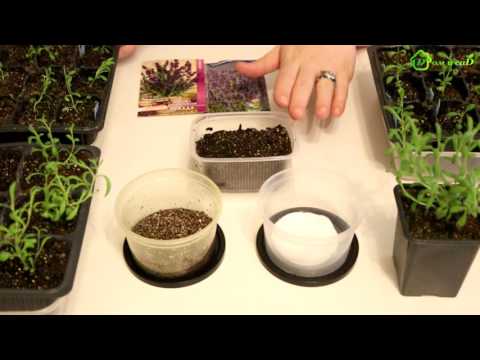

Watch this video on YouTube
Landing in open ground
Seedlings are planted in open soil in the last days of May.Often this shrub is used to decorate alpine hills, to create curbs, or it is planted on both sides of the paths. The culture grows well in open, sunny areas. Since lavender reacts extremely negatively to excess moisture, it is not recommended to choose an area with a high level of groundwater or wetlands for planting it. Sandy loam dry soil is perfect for growing it, but it also grows quite well on drained loamy soil. The recommended pH of the land on the site is 6.5–7.5. If the soil is acidic, then crushed limestone should be added to it.
Before proceeding with planting, the site should be well prepared. To do this, it is dug to a depth of at least 0.2 m, and then the soil is loosened well, for this, compost or peat is added to it.
When planting seedlings of vigorous varieties, a distance of about 1.2 meters is observed between the bushes. When planting seedlings of other varieties, the distance between plants should be from 0.8 to 0.9 meters. The planting hole is made so deep that the root system of the bush can fit in it. Before planting a seedling, its roots must be trimmed a little, after which the bush is placed in a hole and covered with earth. After planting, the root collar should be buried 40–60 mm into the ground. Planted seedlings need abundant watering.
Winter sowing
In regions with a mild climate and warm winters, it is recommended to sow seeds directly into open ground. Sowing is carried out in October in a pre-prepared area. To do this, it is dug up and simultaneously peat is introduced into the soil. If the soil is excessively wet, then this can be corrected by adding sand or fine gravel to it, which will increase its drainage properties. The seeds are buried in the soil by 30–40 mm, after which its surface is slightly tamped. If the autumn is dry, the crops are watered moderately. When the first snow falls, they should cover the surface of the site so that a not very large snowdrift is obtained.
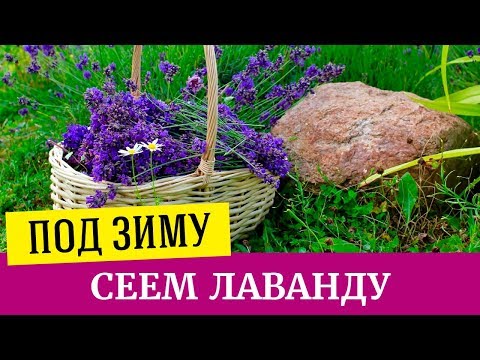

Watch this video on YouTube
Caring for lavender in the garden
After the first inflorescences are formed on the lavender seedlings, it is recommended to cut them off. Thus, young bushes will not waste their energy on the formation of flowers, but will be able to get stronger and form a powerful root system. After planting lavender in the garden, during the first season, it is characterized by extremely slow growth, in this regard, you need to regularly pull out weeds, as they can drown out young shrubs.
In addition, the bushes will need to be systematically trimmed and fed. At the same time, it is recommended to use potash fertilizers for feeding. The fact is that nitrogen fertilizers and manure contribute to the active growth of green mass, and this negatively affects flowering.
Watering and hilling
In order for lavender to grow and develop well, it needs abundant systematic watering. On hot days, the frequency of watering is significantly increased. Every time after rain or watering, loosen the soil between the plants and remove all weeds. In order to significantly reduce the number of weeding, loosening and watering immediately after the seedlings are planted in open soil, the surface of the earth between them is covered with a layer of mulch (peat).
Old shrubs in spring and autumn are sure to huddle high. Thanks to this, new shoots can form on the old branches.
Pruning
Such shrubs need systematic pruning, which is carried out every year. Immediately after the bush has faded, the inflorescences that have begun to fade are cut off, and in the autumn, the branches are shortened to give the lavender a neat shape. Make sure that it does not stretch strongly upward, as due to powerful gusts of wind, the bush may lie down, as a result of which it will lose its decorative effect.After the age of the plant is 10 years or more, if necessary, you can carry out anti-aging pruning, for this, all branches are cut off, while leaving only segments about 50 mm long. Such pruning can be arranged for a younger shrub if it blooms very poorly.


Watch this video on YouTube
Reproduction methods
Lavender can be grown from seed and propagated by layering, dividing the bush and grafting. How to grow it from seeds is described in great detail above.
Propagation by cuttings
This breeding method is suitable for those who already have lavender on the site or have the opportunity to get its lignified annual shoot. The stem is cut into lengths from 80 to 100 mm. The resulting cuttings are planted for rooting in a loose moist substrate, while their lower cut is deepened by about 20–30 mm. Top them are covered with transparent glass jars. It will be possible to remove the shelter only after the roots have grown in the cuttings.
Dividing the bush
For propagation of culture, the method of dividing the bush is also used. However, the plant should be prepared for this procedure. Choose a mature, overgrown shrub. With the onset of autumn, when it fades, it should be pruned to a height of about 10 centimeters, after which it is spud high, trying to fill all the space between the stems with soil. In spring, the plant is huddled again. During the summer, the bush forms abundant growth.
With the onset of autumn, the bush is removed from the ground and divided into several parts with well-developed roots and stems. Further, the delenki are planted in a new place in separate holes.
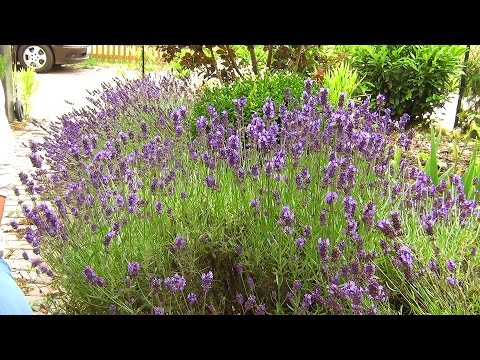

Watch this video on YouTube
Reproduction by layering
In order to propagate the shrub by layering, in the spring, you should select several stems, bend them and put them in grooves 30 to 40 mm deep, made in the soil near the plant. Fix the shoots in this position, cover them with soil and water them well. During the summer period, make sure that the soil above the layers is always in a slightly damp state. It is possible to separate the cuttings that have given the roots from the bush only with the onset of the next spring period. Next, the layers are dug up and planted in a permanent place.
Lavender pests and diseases
When grown in open soil, lavender is highly resistant to harmful insects and diseases. However, problems can arise with her. In some cases, the shrub is affected by gray rot or rainbow beetles or slobbering pennies (leafhoppers) settle on it.
If pests have settled on the bush, then you can get rid of them by collecting insects by hand. Then be sure to replace the mulching layer under the bush. The development of gray rot is facilitated by regular stagnation of liquid in the soil, which can be caused by excessively frequent and very abundant watering or prolonged rains. Such a disease does not respond to treatment, so it is recommended to dig up and destroy the affected bush. If the disease is at the initial stage of development, then you can try to save the lavender, for this, immediately after detection, all affected parts of the bush are cut out. And then the irrigation regime is necessarily adjusted.
Growing in the suburbs and Moscow
Narrow-leaved lavender (medicinal or English) grows best on the territory of Moscow and the Moscow region. It is necessary to plant it in the ground and take care of it in average conditions in the same way and almost at the same time as in warmer regions. Sowing seeds directly into open soil is carried out from the middle to the end of May, immediately after the return frosts are left behind. Planting seedlings in open ground is carried out in the first days of June. It is not recommended to sow seeds before winter, because there is a high probability that they will freeze.
Lavender in winter
If in the region where lavender grows, it is colder than minus 25 degrees in winter, then the plant will need a reliable shelter. Remember that it is impossible to insulate it with flying foliage, since rot may appear on the bush under it. Experienced gardeners in the fall carry out the obligatory pruning of the bush and throw it in spruce branches for the winter. In regions with warmer and milder winters, narrow-leaved lavender does not need shelter.
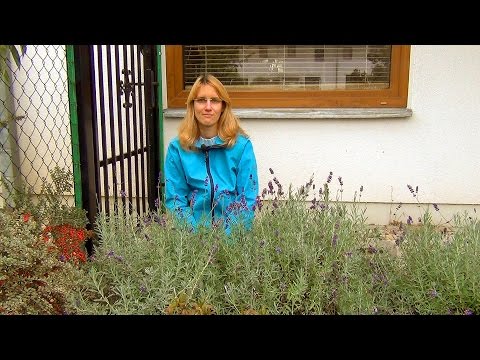

Watch this video on YouTube
Types and varieties of lavender with photos and names
To date, gardeners cultivate only broad-leaved and narrow-leaved lavender. Below, we will also describe those types of lavender that can also be grown in your garden.
French lavender (Lavandula stoechas)
Or lavender broadleaf (Lavandula latifolia). The homeland of this species is Southwest Europe. The scent of the spectacular flowers of such lavender is very strong, they can be painted in various shades of pink, green, white, purple, lilac or burgundy. This lavender blooms a little earlier than other species, and this happens in April-May. Flowering ends in July, but sometimes in the last summer weeks the bush blooms again. Compared to narrow-leaved lavender, this species is not so highly resistant to frost, therefore it is cultivated mainly in regions with a warm and mild climate. The most popular variety among gardeners is Lavandula stoechas pedunculata, or "butterfly" (Papillon): the flowers of this shrub have an unusual spectacular shape. The best varieties of lavender are:
- Yellow Vale... The foliage of the shrub is greenish-yellow in color, the flowers are dark purple, and the bracts are crimson.
- Regal Splendur... The flowers are dark purple.
- Rocky Road... This variety has appeared relatively recently. Its large bluish-lilac flowers open in July.
- Tiara... Bracts in large blue cream flowers.
- Helmsdale... The flowers are colored burgundy lilac.
Hybrid lavender (Dutch)
This group of hybrids, characterized by high decorativeness, was created using English lavender and other species of the genus. Such a large shrub is decorated with narrow leaf plates of a silvery color, as well as large oblong flowers, located on long peduncles that bend under their weight. It blooms in July. The best varieties include:
- Alba... The flowers are white.
- Arabian Knight... The color of the flowers is dark purple or dark blue.
- Sawyers... The color of the flowers is lavender.
- Grosso... Large beautiful flowers are painted in lilac-purple color.
- Richard Gray... The compact bush is decorated with dark purple flowers.
Toothed lavender (Lavandula dentata)
This species comes from the Mediterranean. It is a compact shrub characterized by thermophilicity. The silvery leaf plates are cut and soft. In July, bloom is observed, during which large fragrant flowers open. The species is not highly resistant to frost. The most popular variety among gardeners is the Royal Crown: the flowers are painted in purple.
Narrow-leaved lavender (Lavandula angustifolia)
Or English lavender (Lavandula spicata), or medicinal lavender (Lavandula officinalis). The homeland of this shrub is Southern Europe. This perennial is decorated with greenish-silvery foliage, as well as small lilac-blue flowers. Flowering begins in July – August. This species differs from the others in that it has the highest resistance to frost. The most popular variety of such a shrub is dolphin-like lavender: the height of the bush is no more than 0.3 m, it is decorated with very spectacular leaves of a silvery color. Lavender Headcoat is also widely cultivated, most often it is used to create not very high hedges. The best varieties include:
- Alba... Half-meter bushes adorn white flowers.
- Rosea... A short shrub, reaching a height of about 0.4 meters, during flowering forms mauve inflorescences.
- Manstad... The bright blue flowers bloom on a bush that reaches a height of 0.4 meters.
- Headcoat Giant... The height of such a compact shrub is about 0.6 m.
- Headcoat Blue... Violet-blue flowers adorn the compact plant, which reaches a height of about 0.4 m.


Watch this video on YouTube
Lavender properties: harm and benefit
Medicinal properties of lavender
Lavender has an essential oil in all aerial parts; it contains linalool, coumarins, ursolic acid, tannins, geraniol and borneol. Lavender oil is very useful, due to this it is widely used both in medicine and in the perfumery and cosmetic industry. This oil is used to treat bruises and burns. Lavender is also used in the treatment of cerebrovascular diseases, seizures and paralysis after a stroke, and it can also help with dizziness, headaches and drowsiness. The culture has a diuretic effect, and it is also able to eliminate toothache. Tea with this plant is used to eliminate stomach discomfort and cramps. It can also help with melancholy, irritability, hysteria and neurasthenia, as well as with flu, asthma, bronchitis, whooping cough, tuberculosis, enteritis, flatulence, atony of the gastrointestinal tract, worms, rheumatism, cystitis, amenorrhea, hypertension, fever and various rashes ...
Experts note that lavender infusion has a positive effect on the human nervous system as a whole, as well as on his general mental state. It helps to eliminate stress, as well as to reduce the negative impact of adverse factors on the mental state and consciousness of a person. It was also noticed that the infusion promotes the stimulation of mental activity and the rapid restoration of energy and strength. Lavender foliage is used for the preparation of healing baths, and dried inflorescences are used as an effective anti-moth remedy when storing clothes, and also as a fragrance for linen and room.
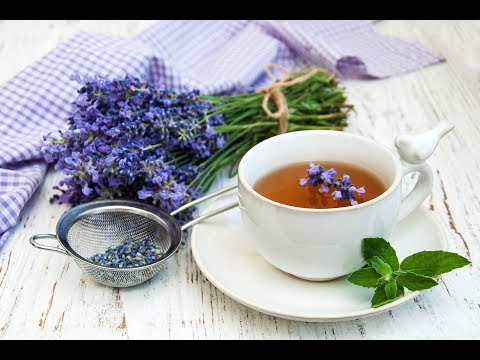

Watch this video on YouTube
Contraindications
Lavender oil should not be used by pregnant women, especially in the early stages, because lavender helps to stimulate the contraction of the muscles of the uterus. It is also forbidden to use it after an abortion, as in this case it can cause bleeding. Also, lavender cannot be used simultaneously with preparations that include iodine or iron. Prolonged use of the oil can cause depression, as well as irritation of the gastrointestinal mucosa. Products made on the basis of lavender have a powerful effect, and therefore can cause a severe allergic reaction. In this regard, before using such a drug for the first time, it is imperative to consult with a qualified specialist.


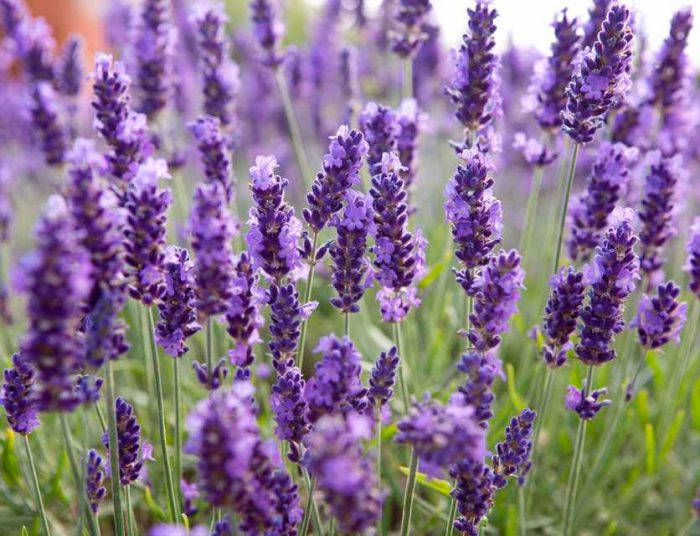
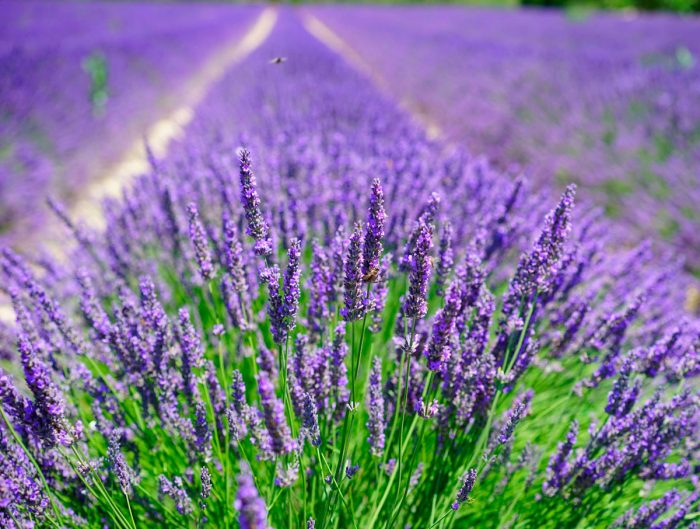
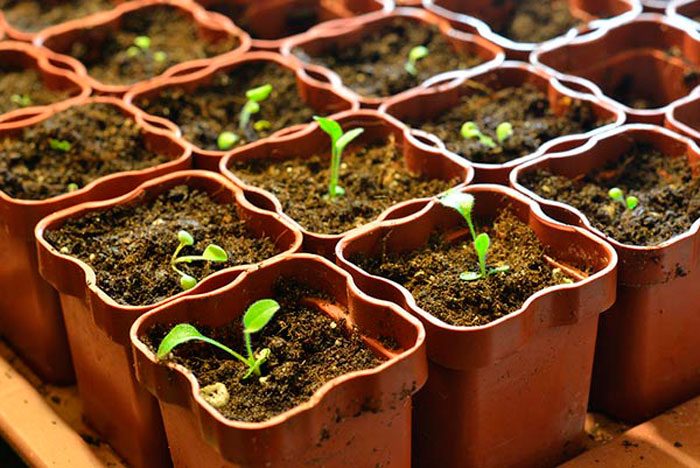
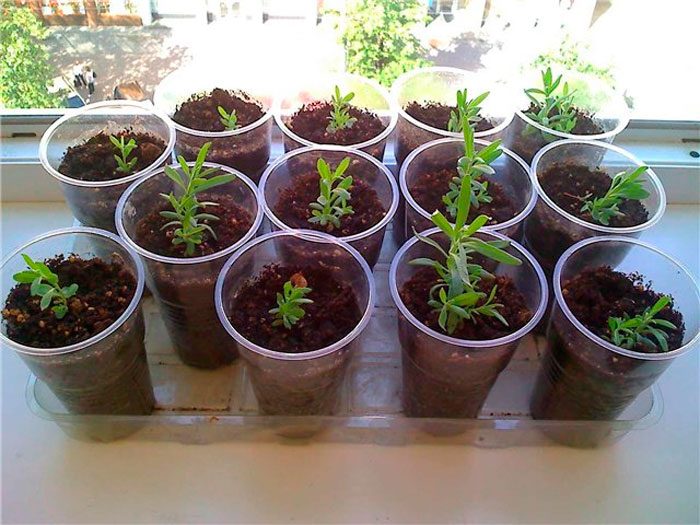
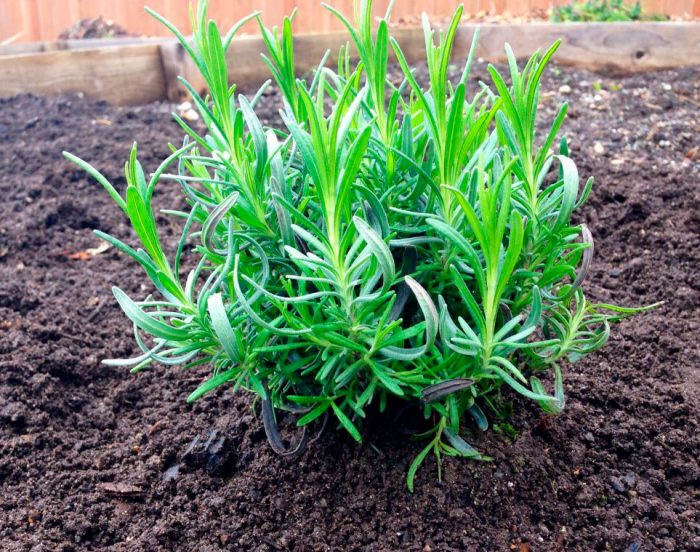
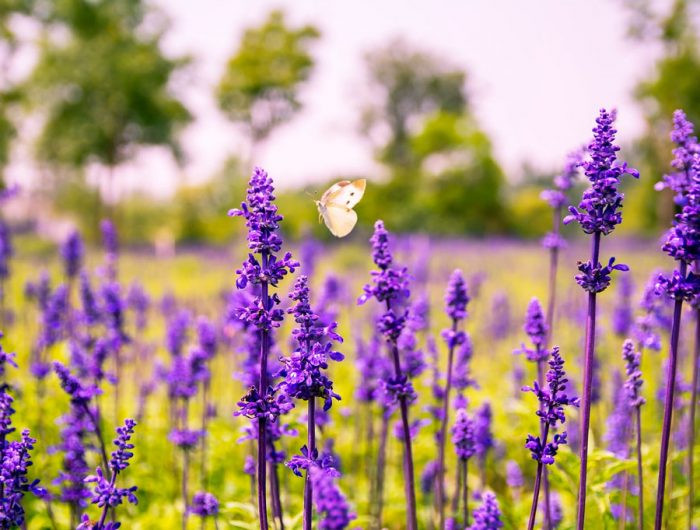
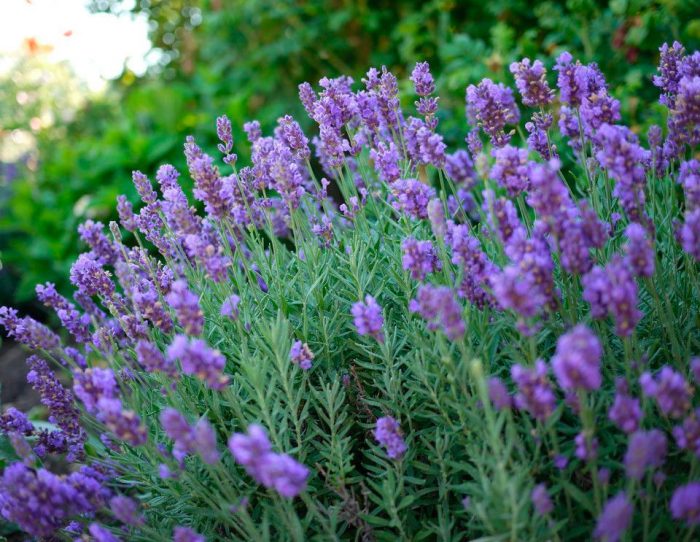
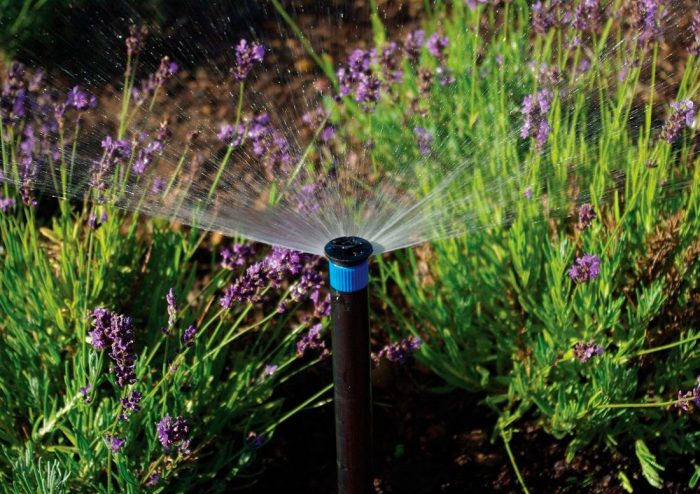
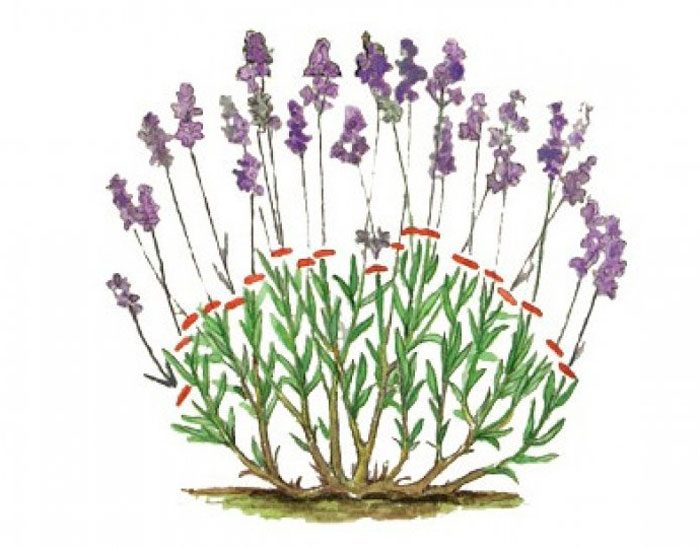
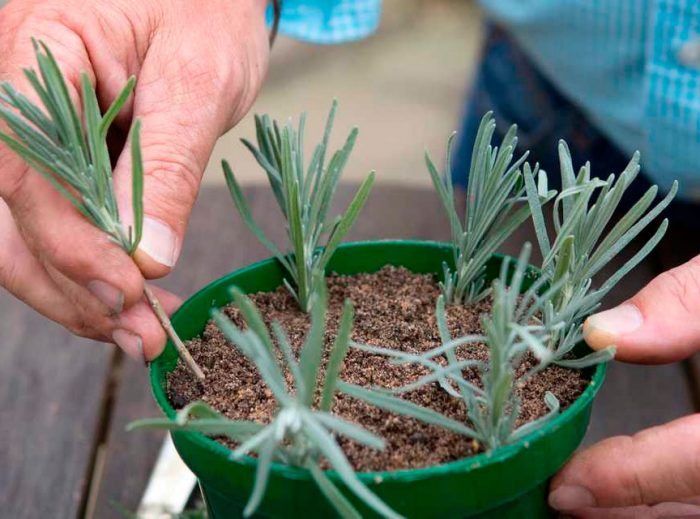
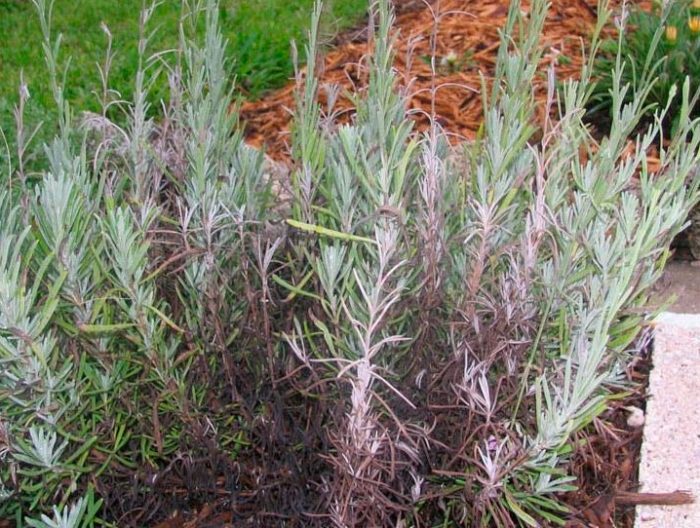
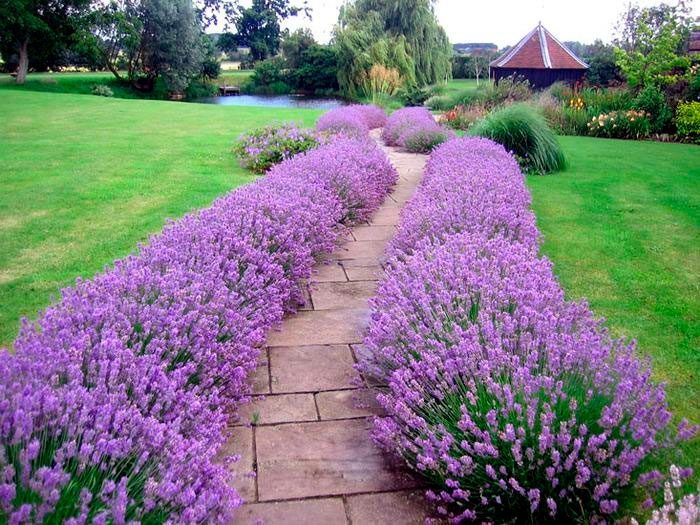
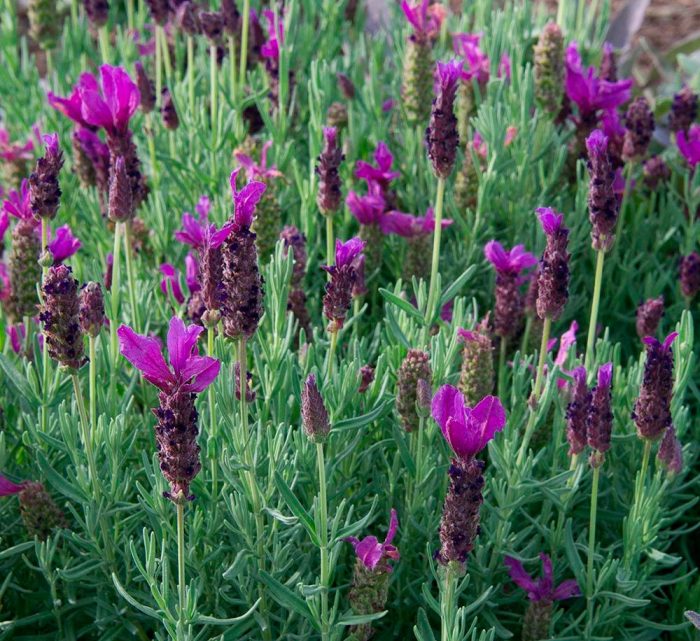

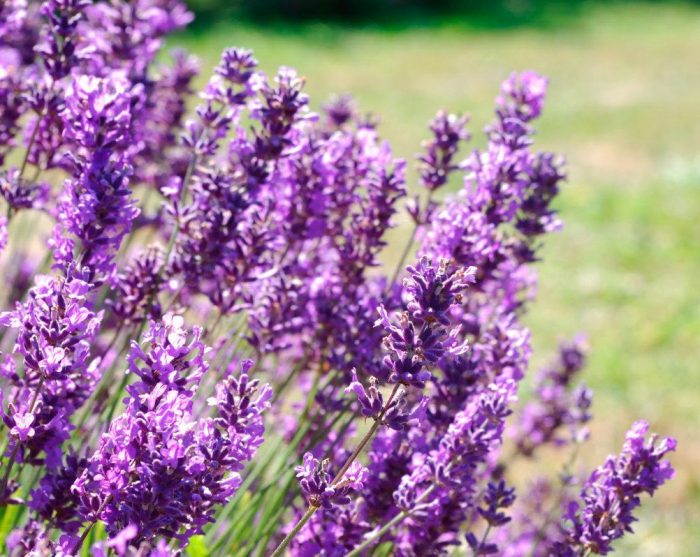

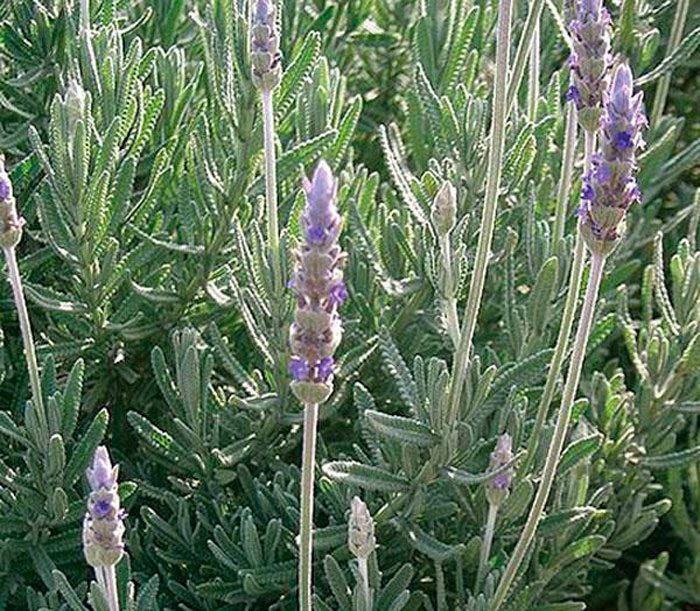
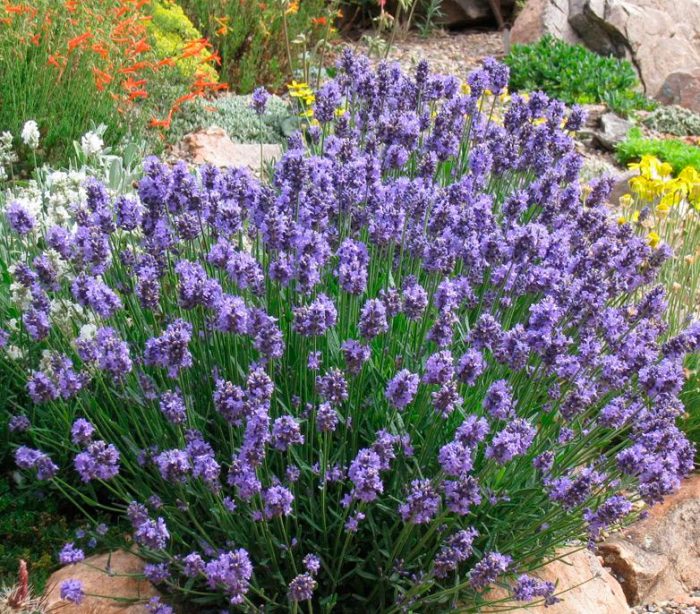

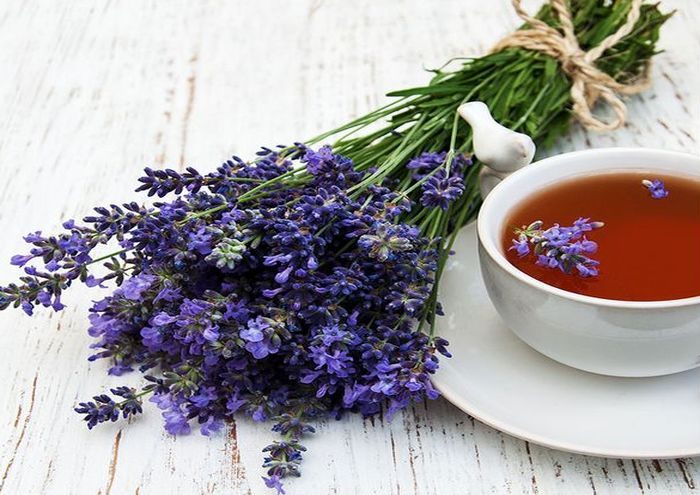

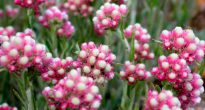

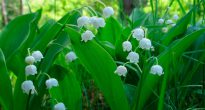
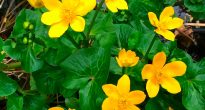





I want to grow Lavender outdoors, can I sow seeds outdoors, not seedlings
It seems that everything above is described in detail)))
Is it possible in July-August to separate the layers, sprinkle them with earth for further rooting and reproduction in the spring of next year? thank